This study provides a comprehensive evaluation of the AirPods Pro 2’s performance as hearing aids, focusing on their Hearing Aid Mode, Media Assist Mode, and Conversation Boost feature.
By Nicky Chong-White, PhD; Matthew Croteau, MClinAud; Padraig Kitterick, PhD; and Brent Edwards, PhD of National Acoustic Laboratories in Sydney, Australiia
Introduction
Apple’s introduction of FDA-approved hearing aid software for the AirPods Pro 2 represents a significant step in integrating consumer technology into hearing care for individuals with mild-to-moderate hearing loss. Users can now conduct a hearing test on their iPhone and easily configure their AirPods Pro 2 based on the results. This feature offers a streamlined and accessible approach to addressing hearing needs and aims to promote greater awareness of hearing health.
The software transforms these widely adopted consumer earbuds into low-cost alternatives to traditional hearing aids. However, questions remain about their effectiveness. How well do they assist hearing?
Our prior research has evaluated the hearing assistive features of the AirPods Pro (1st generation) (Chong-White et al., 2021, 2022; Valderrama et al., 2023), and updated noise cancellation capabilities in the AirPods Pro 2 (Chong-White et al., 2023). In this article, we focus on the newly released Hearing Aid Feature (HAF), launched in the USA in October 2024, and present findings from our comprehensive laboratory measurements. Specifically, we investigate:
- Insertion gain for environmental sounds across various hearing loss profiles,
- Media streaming gain to enhance audio playback, and
- Beamforming and signal-to-noise ratio (SNR) improvements aimed at improving speech understanding in noisy environments
These findings aim to provide clinicians and individuals with hearing loss with a clearer understanding of the AirPods Pro 2’s HAF capabilities. By analyzing their performance under controlled conditions, we seek to shed light on the devices’ potential role in hearing care and how they may benefit users.
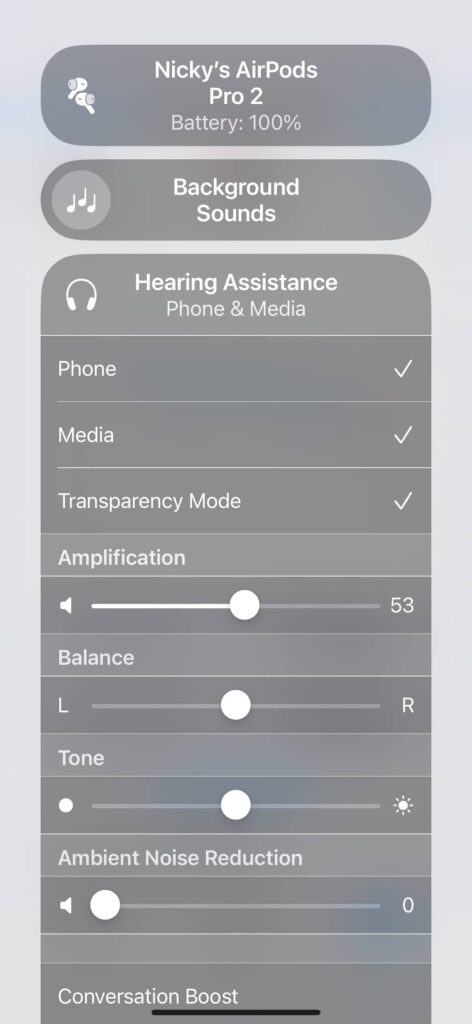
Figure 1. Hearing Control Panel on iPhone showing hearing aid feature options and fine-tuning controls
Hearing Aid Insertion Gain
Hearing Aid Mode is designed to amplify ambient sounds and tailor amplification to the user’s hearing loss profile, providing support for everyday listening and communication. As shown in Figure 1, the iPhone’s Hearing Control panel provides an interface for enabling and adjusting a limited range of features, including amplification, tone, and balance. The AirPods Pro 2 were set to Transparency Mode, which is required for Hearing Aid functionality, for these measurements.
Method:
Controlled laboratory measurements were conducted in an acoustic test room using a B&K Head and Torso Simulator (HATS). The AirPods Pro 2 (firmware 7B19) were paired to an iPhone running iOS 18.1 and inserted into HATS’ ears. The Ear Tip Fit test, a built-in feature of the AirPods Pro, was run to confirm a proper seal in the ear canal.
The International Speech Test Signal (ISTS) was used as the input stimulus, played from a loudspeaker positioned directly in front of the HATS at calibrated levels of 50, 65, and 80 dB SPL. These levels represent soft, average, and loud speech. Hearing loss profiles were uploaded into the Apple Health app to configure the AirPods Pro 2 for hearing aid use. The profiles tested included mild sloping, moderately sloping, and flat hearing loss configurations (Figure 2). Audiograms could be added by taking a photo, uploading from a stored file, or manually entering thresholds by frequency and ear.
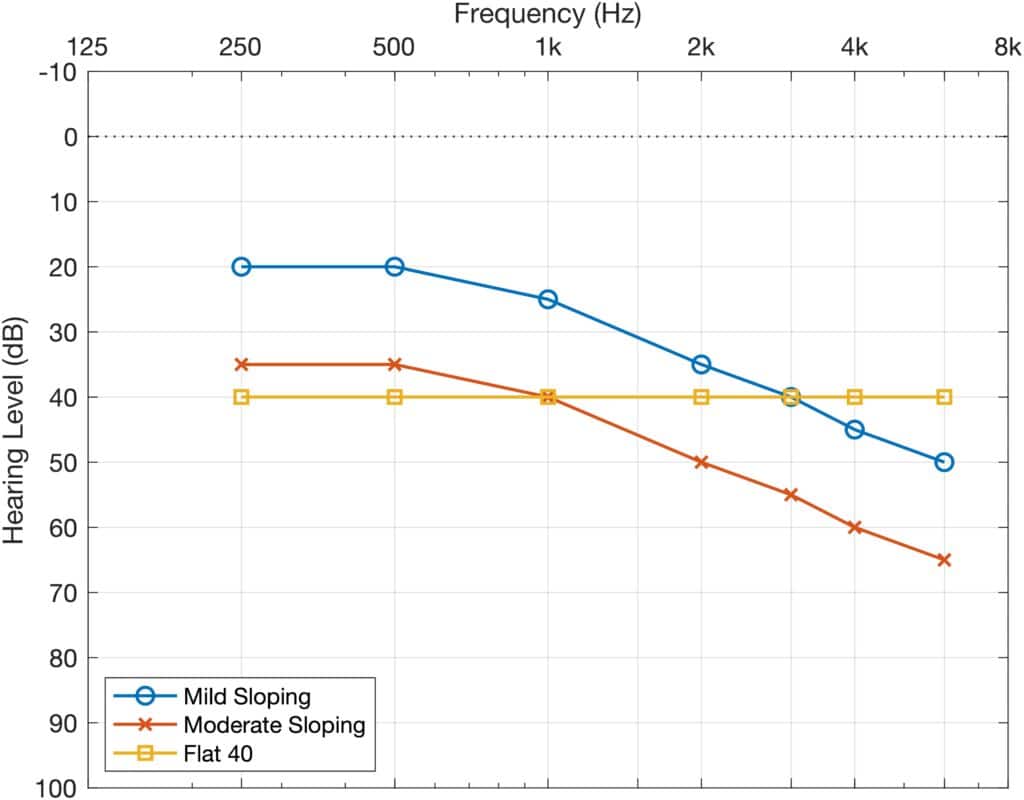
Figure 2. Audiograms of hearing loss configurations using in testing
The output waveform was measured for each ear and analyzed in third-octave frequency bands, then compared to the unaided condition (open ears). The results were evaluated against the insertion gain targets specified by the NAL-NL2 prescription formula. By default, the Apple HAF applies conservative amplification settings, within an adjustable range of +/-6 dB, likely to accommodate new users who may prefer a gradual increase in amplification. The results presented here reflect measurements taken with the amplification slider set to its maximum setting via the iPhone Hearing Control Panel.
Results and Discussion:
Graphs of real-ear insertion gains measured with the AirPods Pro 2 in Hearing Aid Mode for soft, medium, and loud speech inputs are shown in Figure 3.


Figure 3: Real-ear insertion gain (REIG) measured with the AirPods Pro 2 Hearing Aid Feature (HAF) for a) moderate hearing loss and b) flat 40 dB loss at input levels of 50, 65 and 80 dB SPL. NAL-NL2 targets are overlaid for comparison.
Amplification in the mid frequency range (1-4 kHz) closely matched the NAL-NL2 real-ear insertion gain targets across all input levels. This demonstrates an improvement over the previous Headphone Accommodations feature, which under-amplified soft sounds and over-amplified loud sounds, indicative of a reduced compression ratio.
Gain exceeded NAL-NL2 targets for low-frequency sounds. This is likely due to the closed-fit seal of the AirPods Pro, which enhances low-frequency sound compared to the vented or open fittings commonly used in traditional hearing aids. The closed design may affect comfort and perception of one’s own voice. Additionally, the NAL-NL2 formula is designed to maximize speech intelligibility while maintaining comfortable loudness. Since mid-frequencies (1–4 kHz) are critical for speech clarity and contribute the most to the Speech Intelligibility Index (SII), NAL-NL2 prioritizes gain in this range over low frequencies.
For loud input levels, the Apple HAF did not reach NAL-NL2 targets for more moderate hearing loss profiles. This may reflect built-in limitations on overall output levels, potentially in compliance with health and safety regulations to prevent excessive sound exposure. The graphs also reveal peakiness between 6–8 kHz, potentially caused by resonance effects in the ear canal due to the shallow insertion depth of the AirPods Pro speakers.
Overall, the Apple HAF demonstrates close alignment with NAL-NL2 targets in the critical mid-frequency range, with some deviations in low and high frequencies likely due to their physical design and output limitations. These findings highlight the potential of AirPods Pro 2 to provide effective amplification for hearing assistance.
Media Streaming Gain
Media Assist Mode is designed to enhance the listening experience for streamed content such as music, podcasts, movies, or phone calls for individuals with hearing loss.
Method:
The performance of the AirPods Pro 2 in Media Assist Mode was evaluated by measuring the amplification provided during Bluetooth media streaming from an iPhone. The amplification profile was assessed by comparing the output levels when Media Assist Mode was activated versus deactivated, both with the AirPods Pro 2 in place.
The International Speech Test Signal (ISTS) was streamed directly to the AirPods Pro 2. Calibration was performed by adjusting the iPhone volume until the root mean square (RMS) output level of the AirPods Pro 2 matched the RMS level equivalent to an open ear receiving input levels of 50, 65, and 80 dB SPL. Measured levels were cross-checked and confirmed to be within 1–2 dB of the instantaneous Headphone Audio level, as shown in the Hearing Control Panel.
Results and Discussion:
Graphs of the gains measured with the AirPods Pro 2 in Media Assist Mode, i.e. Hearing Aid mode applied to media and phone calls, are shown in Figure 4 (a and b), below. .
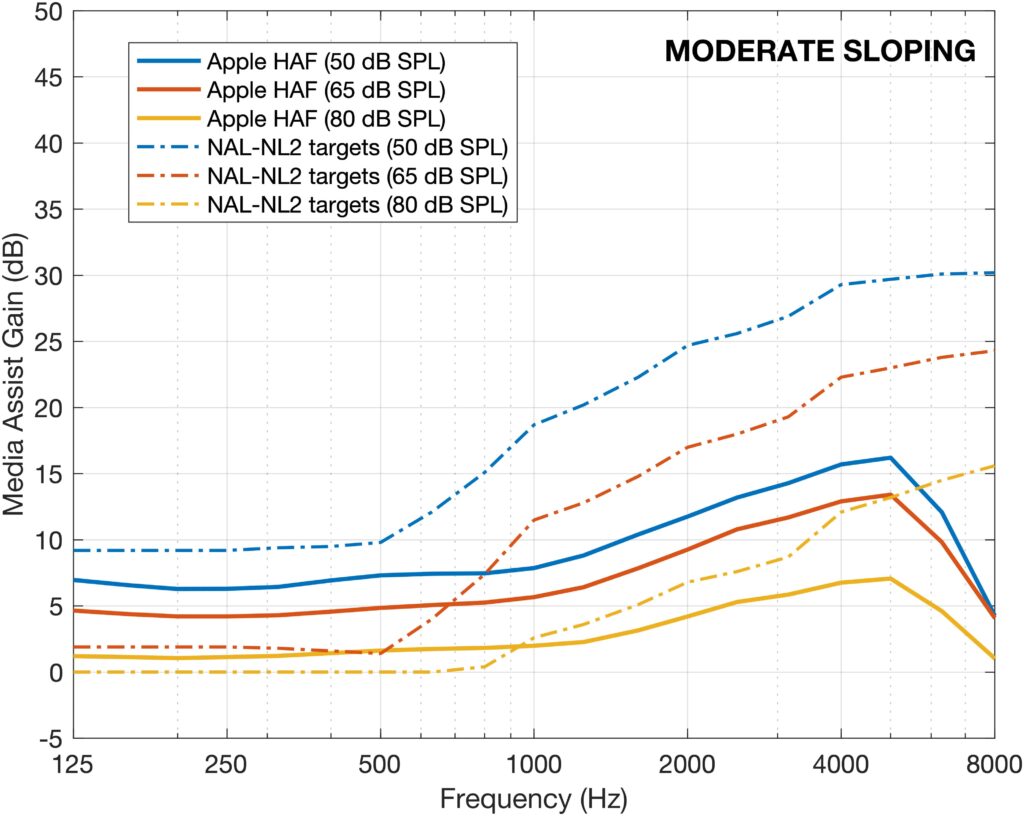
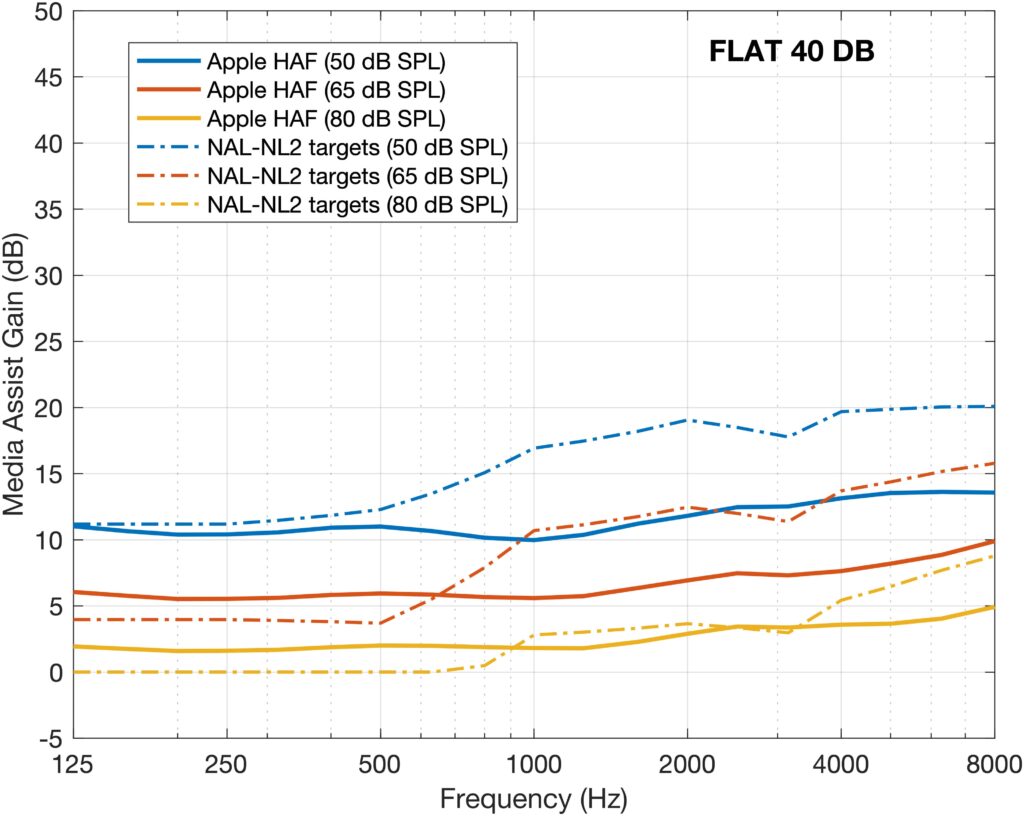
Figure 4: Media Assist gain for the AirPods Pro 2 for a) moderate hearing loss and b) flat 40 dB loss at input levels of 50, 65 and 80 dB SPL. NAL-NL2 targets are overlaid for comparison.
When comparing the AirPods Pro 2 output in Media Assist Mode (Figure 4), notable differences were observed compared to when in Hearing Aid Mode (Figure 3). In the mid-to-high frequencies (>1 kHz), amplification was significantly lower than NAL-NL2 targets, while in the low-frequency range (<1 kHz), amplification exceeded NAL-NL2 targets, giving a pronounced bass boost.
These findings suggest that Media Assist Mode prioritizes a mild and balanced amplification profile for general media consumption rather than a prescriptive approach focused on speech intelligibility. The conservative gain adjustments likely aim to provide a pleasant listening experience across diverse content types. Users retain the ability to further adjust the volume or emphasize bass or treble using their iPhone, providing additional customization for their listening preferences.
Beamforming and SNR improvement: Conversation Boost
The Conversation Boost feature can be manually activated from the Hearing Control Panel when the AirPods Pro 2 are in Hearing Aid Mode. It uses beamforming technology to improve speech clarity in noisy settings by focusing the microphone beam in the frontal direction, and suppressing sounds from the sides and rear.
1. Signal-to-Noise Ratio (SNR) Improvement
Method:
SNR improvement was evaluated in a simulated noisy environment using the Hagerman method (Hagerman & Olofsson, 2004). Measurements were conducted in an acoustic test room with loudspeakers arranged in a horizontal circular array (3.6 m diameter). A challenging diffuse noise field was created using 16 equally spaced loudspeakers, each playing uncorrelated multi-talker babble noise, calibrated to 65 dB SPL at the listener’s (HATS) position. Target speech, the ISTS, was presented from the loudspeaker at 0° azimuth. The SNR was set to -3 dB, reflecting challenging real-world environments such as cafes or restaurants.
Using the Hagerman method, the speech stimulus was presented twice, with the phase inverted during the second presentation. Summing the recordings canceled the speech component, isolating the noise signal, while subtracting the recordings canceled the noise, isolating the speech signal. SNR at the ear was calculated for each condition.
Target speech and noise signals were captured using the HATS microphones and analyzed through a one-third octave filter bank. The SNR and SNR advantage (the difference in SNR between test and reference conditions) were calculated for each frequency band and then averaged.
Measurements were conducted under four conditions: (1) Conversation Boost (CB) off and Ambient Noise Reduction (ANR) 0%, (2) CB on, ANR 0%; (3) CB off, ANR 100% and (4) CB on, ANR 100%.
Results and Discussion:
Table 1 presents the measured SNR levels for each condition in the Moderate HL and Flat40 hearing profiles. The combination of CB (Conversation Boost) and 100% ANR (Ambient Noise Reduction) provided an average SNR improvement of 3.5 dB, while CB alone resulted in a 2 dB improvement.
These results indicate that CB can enhance speech understanding in moderately noisy environments, particularly when paired with ANR. However, traditional hearing aids with adaptive or super-directional microphones are likely to provide greater levels of SNR improvement and outperform AirPods Pro 2 in more complex listening situations involving dynamic noise sources.
| Condition | Moderate HL (dB) | Flat 40dB HL (dB) |
| CB OFF, ANR 0 | -3.8254 | -3.3611 |
| CB OFF, ANR100 | -2.7968 | -2.0637 |
| CB ON, ANR 0 | -1.8799 | -1.5268 |
| CB ON, ANR 100 | -0.2746 | 0.2803 |
| SNR Advantage | 3.55 | 3.64 |
Table 1: Signal-to-Noise Ratio (SNR) Levels and SNR Advantage with Conversation Boost (CB) and Ambient Noise Reduction (ANR)
2. Beamforming and Polar Patterns
Method:
To assess the directional performance of Conversation Boost (CB), polar patterns were measured. Speech (ISTS) was played sequentially from each of the 16 loudspeakers in the circular array with no background noise present. Each loudspeaker delivered the signal at 65 dB SPL.
Measurements were conducted with CB turned on and off to evaluate the AirPods Pro 2’s ability to enhance frontal sound focus and suppress sounds from other directions. Signals were captured using HATS. The resulting polar patterns were analyzed at both broadband and octave frequency levels to quantify the directional effect across different frequency ranges.
Results and Discussion:
Figure 5a illustrates the polar patterns of broadband sound for the Moderate HL audiogram profile with CB turned off. In this condition, sounds are picked up from all directions similarly. In contrast, with CB activated (Figure 5b), the patterns show improved audio pickup from the frontal direction. Analysis of polar plots for individual frequency bands revealed that this directionality effect is most pronounced at mid-to-high frequencies (2 kHz and 4 kHz).
This effect is further quantified by the Directivity Index, shown in Figure 6. The graph highlights frequency-dependent improvements, demonstrating increased directivity with CB on compared to CB off, particularly in the mid-to-high frequency range.
The results confirm that the beamforming capability of Conversation Boost effectively enhances speech from the front while suppressing sounds from other directions. This feature is particularly beneficial for one-on-one conversations or focused listening, such as during a presentation.
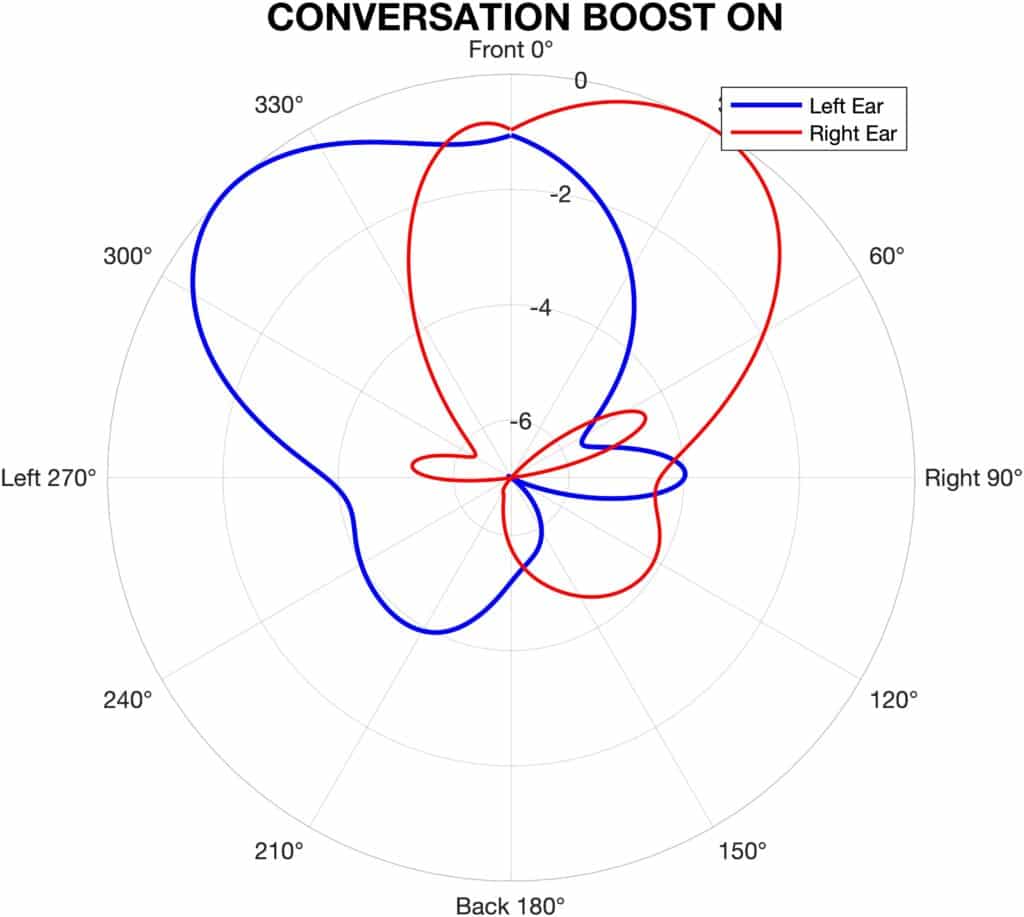
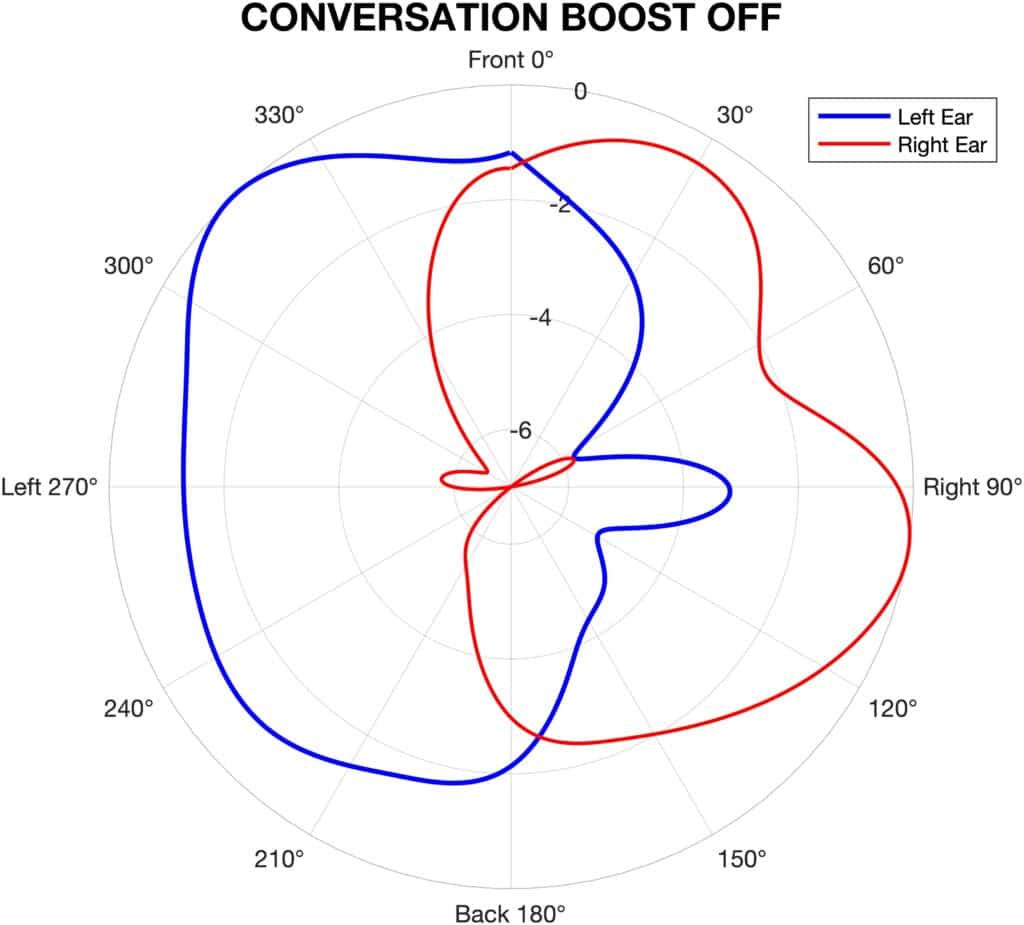
Figure 5: Polar Plots of broadband sound reception for Moderate HL audiogram profile with (a) CB turned Off and (b) CB turned On

Figure 6: Directivity Index of Apple HAF, Moderate HL Profile with Conversation Boost (CB) On and Off
Summary
This study provides a comprehensive evaluation of the AirPods Pro 2’s performance as hearing aids, focusing on their Hearing Aid Mode, Media Assist Mode, and Conversation Boost feature. These consumer earbuds offer accessible, stigma-free hearing support for individuals with mild-to-moderate hearing loss, making them an appealing introductory option for those not ready to adopt traditional hearing aids.
The AirPods Pro 2 effectively amplify sounds in the environment, with mid-frequency gains closely aligning with NAL-NL2 targets, aiding speech intelligibility. Media Assist Mode provides mild amplification, including enhanced bass, and allows users to adjust loudness through volume controls. Conversation Boost improves communication in moderately noisy environments by focusing on frontal sounds and reducing side and rear noise.
However, limitations in loud-level amplification, fine-tuning options, and dynamic noise handling suggest traditional hearing aids remain better suited for individuals with greater hearing needs or in more complex listening environments. Despite these constraints, AirPods Pro 2 serve as a valuable entry point into hearing care, fostering greater awareness and acceptance of hearing solutions. Future software updates could further enhance their features, improving their performance and expanding their appeal.
Apple’s advancements in hearing health with the AirPods Pro 2 represent a significant step toward making hearing care more accessible and potentially reducing the stigma around hearing loss. Key considerations for users when considering AirPods Pro 2 as a device to help with their hearing loss include sound quality, performance in challenging environments, comfort, battery life, the severity of hearing difficulty, and the willingness to wear earbuds for regular hearing support. As AirPods become increasingly used for purposes beyond consuming audio, they may help shift public perception of hearing devices. Our future work will focus on evaluating the real-world performance and user satisfaction of AirPods Pro 2 across a range of environments, levels of hearing difficulty, and use cases.
About the Authors
Nicky Chong-White, PhD, is Principal Engineer at National Acoustic Laboratories in Sydney, Australiia, and leads the Smart Technology Innovation Portfolio. Chong-White brings extensive experience in hearing research and digital health innovation, with deep expertise in audio signal processing, AI, and mobile technologies.
Matthew Croteau, MClinAud, is a research audiologist at NAL with a strong background in audiology, acoustics, and sound engineering. Croteau’s work spans hearing assessment, rehabilitation, device testing and acoustic analysis.
Padraig Kitterick, PhD, is Head of Audiological Science at NAL. Kitterick’s research focuses on evaluating hearing devices, with expertise in developing outcome measures to support both patients and the clinicians who manage their hearing health.
Brent Edwards, PhD, is the Director at NAL and leads research and innovation initiatives that transform hearing healthcare. Edwards has over 20 years of experience heading research for major hearing aid companies and Silicon Valley start-ups.
References:
- Chong-White N, Mejia J, Galloway J, Edwards B. Evaluating Apple AirPods Pro with Headphone Accommodations as hearing devices. Hearing Review. 2021;28(12):8-11.
- Chong-White N, Mejia J, Valderrama-Valenzuela J, Edwards B. Evaluation of Apple AirPods Pro with conversation boost and ambient noise reduction for people with hearing loss in noisy environments. The Hearing Review. 2022;29(4):24-27
- Chong-White N, Mejia J, Edwards B. Evaluating Apple AirPods Pro 2 Hearing Protection and Listening. The Hearing Review. 2023; 30 (6)
- Valderrama J, Mejia J, Wong A, Chong-White N, Edwards B. The value of headphone accommodations in Apple AirPods Pro for managing speech-in-noise hearing difficulties of individuals with normal audiograms. 2024 Jun;63(6):447-457.
- Hagerman B, Olofsson Å. A method to measure the effect of noise reduction algorithms using simultaneous speech and noise. Acta Acustica United with Acustica. 2004;90(2):356-361.





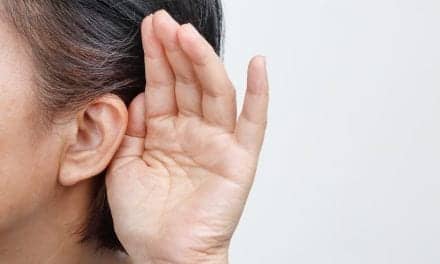
I wonder if the lower than ideal gain at high frequencies for moderate sloping loss would be improved if you turn off the hearing protection feature – certainly I can tell from using the devices this is likely the case – although I leave the hearing protection feature on for obvious reasons. Would be interesting to see the REM measurements with hearing aid mode disabled (would confirm if that peakiness at 6kHz is due to resonance or due to some artifact of the HAF) and also to see the REM measurements for the mild sloping loss case.
Hooray for some proper lab testing! But when it comes to music, there’s still at least an octave unvisited at the low end! Given the inherent good quality of Air Pods, it would be good if the Apple controls offered more than just a high-low slope, welcome though that is. Most people are fully able to use traditional tone controls: bass/treble, cut/boost. They could be such a help in adapting not only to the user’s hearing curve but also to the listening conditions, whether live or mangled by the typical loudspeaker.